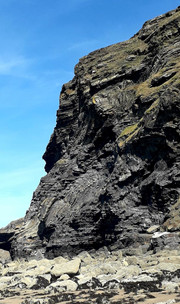Exploring a Magical Edgescape: Cornwall’s Atlantic Coast
- javural
- Jan 7, 2023
- 3 min read

Christmas Day: towering Atlantic rollers barrelling into a high-walled inlet like juggernauts into an alley, smashing themselves into fountains of foam and spray on uncaring cliffs. Swirling and seething, sucking back before the next onslaught. The sky, scoured by the wind, is as grey as the sea. We perch on slick steps cut into the rock near Boscastle harbour where the maelstrom is damped to an exhilarating swell. Balanced just above the heaving water in our swimsuits, we try to ignore the needling raindrops, judging the right moment. Now! The sea rises, floating us free, then falls back taking us with it. A sudden intake of breath as the cold bites - you’re in now, that’s the worst part done - a few strokes - whoa, the cold is insistent, fingers are going numb - back on the rock, struggling with a towel in the wind, huddling into dry clothes. It’s hard to stop shivering - but the glow of satisfaction is warming.
I find it irresistible, this ‘edge’ - the narrow zone between the wild Atlantic Ocean and England’s rugged south-west fringe, the north coasts of Somerset, Devon, and especially Cornwall, so different to the more mellow Mediterranean shores where I live. I’m drawn back year after year - walking the south-west coast path, exploring tiny coves and beaches and sea caves, trying to capture images of subtle changes of mood. Each time I find something new.
The ebb and flow of the tides fascinate me. At home it’s virtually unnoticeable, but here the ocean’s edge is transformed every twelve hours or so as the water recedes, like a curtain being drawn back, revealing a whole new world. Vast expanses of hard flat sand ribbed with ripples; long rows of black rock reaching out into the water like the rib cage of a drowned dinosaur; tiny fish and crabs stranded in rock pools that form in cracks in the rock, darting in and out of the shadows, vulnerable until the water returns; rock-anchored shellfish - mussels and barnacles - exposed and sharp underfoot; dark, cathedral-like caves that stretch back deep into the cliff faces. The retreating tide scours the sand, smoothing it pristine. Venturing onto an empty beach near Lands End as the tide is ebbing, the only footprints my own, I feel like the first person on the moon! Yet a few hours later, all traces of my passing will be erased too.
It’s magical, the intertidal zone, like Narnia or Brigadoon - a land of wonders that only appears at certain times. But like all magic, it has a dark side, often difficult to reach (we accessed one beach by crouching in pitch darkness along a steep and slippery tunnel hacked out of the bedrock), not to mention treacherous to the unwary who forget to keep an eye on the state of the tide.
Natural rhythm, constant flux, a blurred boundary between land and sea.
The cliffs are a different matter, a hard, defined edge. Unchanging. Permanent. Or so they seem at first glance. But the rounded boulders and dust-like sand at their base bear witness to the relentless grinding power of the waves over time . ‘Solid as a rock?’ Not when faced with the pounding of the ocean. And erosion isn’t the only agent of change here. Soaring layered rock formations in the cliffs near Bude, some as thin as paper, others as chunky as bricks, stretch diagonally towards the sky, or zigzag across the vertical face in house-sized
folds. Even rock can be squeezed and deformed like dough by massive forces within the earth.
Humans, too, push at the boundaries between land and sea, the edge-scape. The coast around St Just is littered with remains of the mining industry that used to flourish here, digging for tin and other metals and minerals, including arsenic. But the stone shells of chimneys and engine-houses are like the tip of an iceberg - some of the mines apparently extend far beneath the seabed (the mere thought gives me the shivers). More blurring of boundaries. And at the foot of the cliffs near Lands End, half and and half out of the water, lie the precariously-balanced remains of a cargo ship, the RMS Mulheim, wrecked on the nearby rocks twenty years ago. A graphic reminder that this particular edge can be a risky place to venture.





















Comments